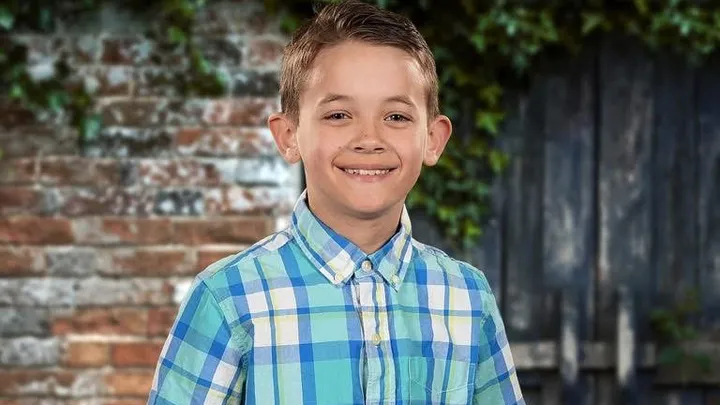Eight-year-old Liam Dahlberg walked through his front door after school, complaining of nothing more than a headache. By the following evening, his mother was holding him as doctors removed life support.
What happened in those terrifying 24 hours would challenge everything his family thought they knew about childhood safety. Despite following every medical recommendation and doing everything right, they lost their vibrant son to an enemy so rare that fewer than 50 cases occur nationwide each year. Now, as Ashlee Dahlberg shares her story, a chilling truth emerges: sometimes even the most protected children can fall victim to dangers lurking in plain sight.
A Normal School Day That Changed Everything
April started like any other month for the Dahlberg family in Indiana. Liam bounded through his days with the energy and enthusiasm that defined his eight years of life. School, friends, family time – everything seemed perfectly normal.
When Liam came home that Tuesday afternoon, mentioning a headache, his mother, Ashlee, didn’t panic. Children often complain of headaches. She gave him some comfort and expected him to bounce back like always.
But on Wednesday morning, a different child emerged. Liam’s usual lively and upbeat demeanor had vanished overnight. Something was wrong with her son, and maternal instincts kicked in immediately.
Ashlee rushed Liam to the hospital, hoping for a simple explanation and quick treatment. Instead, she was about to receive news that would shatter her world.
When Doctors Delivered the Devastating News
Hospital tests revealed that Liam had contracted Haemophilus influenzae type b, commonly known as Hib. The diagnosis sent the medical staff into immediate action, but it was already too late.
An MRI showed the devastating extent of the infection’s spread. Bacteria had covered Liam’s brain and spinal cord, creating a medical emergency with no solution.
“Basically, at that point in time, there was nothing they could do,” Ashlee later revealed to reporters, her voice breaking as she recounted the moment her world collapsed.
“Anybody that contracts it usually dies within 24 hours,” she explained, sharing the brutal reality of this rare bacterial infection that strikes so quickly and thoroughly.
Meet Liam: The Boy Who Brought Joy to Everyone

Liam wasn’t just another statistic in medical journals. He was a bright, energetic boy who filled every room with laughter and love. His personality drew people to him naturally, and his zest for life was infectious to everyone around him.
At eight years old, Liam had his whole future ahead of him. School activities, friendships, family adventures – all the typical joys of childhood that parents take for granted until they’re suddenly gone.
His mother describes him as lively and upbeat, qualities that made his rapid decline even more shocking. One day, he was his usual, happy self, and within hours, he was fighting for his life.
Family and friends remember Liam as a child who brought light into their lives, making his loss feel impossibly cruel and senseless.
What Exactly Is This Silent Killer
Despite its name, Haemophilus influenzae type b has nothing to do with the flu virus that families worry about each winter. Hib is a bacterial infection that operates very differently from viral illnesses.
Many people carry Hib bacteria in their noses and throats without ever getting sick. For most healthy individuals, the bacteria remain dormant and harmless, never causing any symptoms or problems.
Medical professionals sometimes refer to it as “H. flu,” which can create confusion since it’s not related to influenza at all. Understanding this distinction helps parents recognize that Hib poses different risks than seasonal flu viruses.
Hib bacteria can remain hidden in seemingly healthy individuals, making it nearly impossible to avoid exposure in community settings such as schools and playgrounds.
How This Infection Turns Deadly So Fast

Hib spreads through respiratory droplets when infected people cough, sneeze, or even talk. Children in schools and daycare centers are constantly exposed to these microscopic droplets through their daily interactions.
For most people, a strong immune systems keep the bacteria in check. However, when immune defenses are weakened by other illnesses or stress, Hib can break through protective barriers.
Once Hib enters the bloodstream, it gains access to every part of the body. The bacteria can travel to vital organs, including the brain and spinal cord, where they cause devastating damage.
When Hib reaches the central nervous system, it triggers inflammation that can be fatal within hours. Medical treatments often cannot work fast enough to stop the bacterial invasion once it reaches this stage.
Why Vaccines Usually Prevent This Tragedy
Liam had received his Hib vaccinations as a baby, following standard pediatric immunization schedules. His parents had done everything medical experts recommend to protect their son from preventable diseases.
Hib vaccination became routine for infants starting in 1985, then expanded to younger babies in 1990. These vaccines have proven remarkably effective at preventing the devastating infections that once terrorized families.
However, no vaccine provides 100% protection for every person. Breakthrough infections, while extremely rare, can still occur in vaccinated individuals under certain circumstances.
Dr. Eric Yancy, a pediatrician in Indianapolis, explained that breakthrough cases like Liam’s often result from exposure to unvaccinated individuals who carry the bacteria.
The Devastating Numbers Before Vaccines Existed

Before Hib vaccines became available, this bacterial infection wreaked havoc on American families. Medical records from the 1980s paint a terrifying picture of what childhood looked like without protection.
Approximately 20,000 children under age five developed severe Hib disease each year before vaccination programs began. Of those cases, about 1,000 children died annually from the infection.
“If it didn’t kill the children within a very short period of time, it left many of them with significant complications,” Dr. Yancy shared, describing the pre-vaccine era as “absolutely devastating.”
Survivors often faced permanent disabilities, including hearing loss, brain damage, and developmental delays. Families lived in constant fear of this invisible threat that could strike any child at any time.
How Vaccines Changed Everything
The introduction of Hib vaccines represents one of modern medicine’s greatest triumphs. Statistics show the dramatic impact these immunizations have had on child survival rates.
Since 1991, Hib infection rates have plummeted by more than 99% in the United States. By 2019, only 0.15 out of every 100,000 children under five years old developed Hib disease.
In 2024, fewer than 50 cases were reported nationwide, according to CDC data. These numbers represent thousands of lives saved and families spared from unimaginable grief.
Vaccines transformed Hib from a common childhood terror into a rare medical curiosity that most pediatricians never encounter during their careers.
When Vaccinated Kids Still Get Sick

Liam’s case highlights a troubling reality about community immunity. Even vaccinated children can contract Hib when exposed to unvaccinated individuals who carry the bacteria.
Dr. Yancy explained that Liam likely caught the infection from a child who hadn’t received Hib vaccinations. When vaccination rates drop in communities, even protected children face increased risks.
Herd immunity depends on high vaccination rates throughout the population. When significant numbers of people remain unvaccinated, dangerous bacteria continue circulating and threatening vulnerable individuals.
Parents who vaccinate their children often assume they’re fully protected, but community vaccination rates determine everyone’s actual safety level.
A Mother’s Unimaginable Pain
Ashlee Dahlberg’s description of losing Liam reveals the devastating reality of watching a child die from a preventable disease. Her words capture pain that no parent should ever experience.
“To have sat there and listened to the doctors say, ‘You did everything right, there’s just nothing we could do,’ to lay there with him as they took him off life support, I can feel his little heartbeat fade away — there’s no words that can describe that pain.”
Despite following every medical recommendation, Ashlee struggles with feelings of failure and guilt. She battles the impossible burden of believing she should have been able to protect her son from everything harmful.
“I would never wish this kind of pain on my worst enemy ever. It’s hard,” she cried while sharing her story, hoping other families might be spared similar anguish.
Warning Signs Parents Need to Watch For
Hib infections develop so rapidly that early warning signs often appear mild and ordinary. Liam’s case shows how quickly a simple headache can signal life-threatening illness.
Parents should watch for the sudden onset of severe headaches, especially when accompanied by fever, stiff neck, or unusual lethargy. Any combination of these symptoms requires immediate medical attention.
Children may also develop breathing difficulties, a severe sore throat, or a skin rash as Hib spreads through their bodies. These symptoms can progress from mild to critical within hours.
Trust parental instincts when something feels wrong about your child’s condition. Hib moves so fast that early medical intervention provides the only chance for successful treatment.
What Liam’s Story Means for Other Families

Liam’s death serves as a stark reminder that individual vaccination decisions affect entire communities. When some families choose not to vaccinate, they put other children at risk.
Ashlee now advocates for universal childhood vaccination, hoping to prevent other families from experiencing her devastating loss. She understands that protecting all children requires community-wide participation.
“I feel like I have failed my child because I could not protect him from everything that would cause harm,” she said, despite doing everything medical experts recommend.
Her message to other parents is clear: vaccination protects not just your children, but also vulnerable community members who depend on herd immunity for survival.
Making Sure This Doesn’t Happen Again
Preventing future tragedies like Liam’s death requires maintaining high vaccination rates throughout communities. Parents must understand that their individual choices affect the children of everyone.
Current vaccination schedules include Hib immunizations starting at two months of age, with boosters given at regular intervals. Following these recommendations provides strong protection for most children.
Some children cannot receive vaccines due to medical conditions, making them dependent on community immunity for protection. These vulnerable individuals rely on others to make responsible vaccination choices.
Honoring Liam’s memory means ensuring that no other family endures the agony of losing a child to a preventable disease. His story must motivate communities to prioritize vaccination and protect all children from these deadly infections.
Featured Image Source: GoFundMe














Leave a Reply